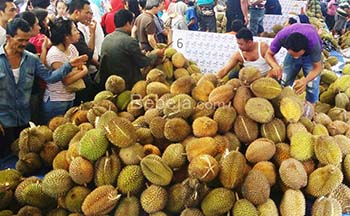Indonesia is home to various types of durian, particularly Durio zibethinus, which has the widest distribution. Durian and its relatives are indigenous to Indonesia and Malaysia and have since spread throughout the tropics in Southeast Asia, the Caribbean, and Latin America.
Kalimantan Island is one of the main centers of durian distribution in Indonesia. According to data from the Bogoriense Herbarium in Bogor, West Java, Kalimantan Island is home to 18 of the 20 types of durian found in Indonesia. Even though 14 types of durian are endemic or only grow on the island of Kalimantan, here are some of the most common types of durian.
A. Durio zibethinus
Durio zibethinus means thorny fruit that smells. But behind the odor, the fruit nicknamed King of Fruits has sweet, savory, delicious, soft, and slightly bitter (alcoholic) flesh, hence the expression, Tastes Like Heaven But Smells Like Hell.
Durio zibethinus flesh color varies from white, cream, and light yellow-parental yellow-copper-orange. Approximately 90% of the current productive zibethinus population consists of natural plants grown from seeds in forest and field habitats. Only 10% of plants are propagated through seeds, resulting in each tree having unique characteristics and potentially warranting multiple names. Clonal plants, on the other hand, must be named after their single-parent tree.
Naming durian varieties can be confusing due to the existence of many similar names in the field. For instance, Copper durian is used for dozens of durian species in Indonesia that share similarities such as copper yellow flesh color and sweetness. However, the texture and moisture content of each type can differ. Therefore, when referring to zibethinus durian, additional information such as the location or owner’s name is necessary, as in Balai Karangan Copper durian, Jemain Copper durian, and South Sumatra Copper durian.
Generic names are trade names (not variety names) used for marketing purposes. For instance, durian medan refers to durian sold in Medan City, although the fruit can come from various regions such as North Sumatra, Aceh, West Sumatra, Riau, Bengkulu, and Lampung.
B. Durio testudinarum
Durio testudinarum, also known as the Tiger durian, is the only durian species whose fruit grows from the base of the stem, making it easily accessible to tigers. The fruit, which is about the size of a takraw ball, is located 15-30 cm from the ground and is typically supported by leaf litter around the base of the tree.
The botanist AJGH Kostermans once referred to testudinarum as Kakura durian or Turtle durian. In his book, The Genus of Durio, Kostermans identifies testudinarum as a species of durian that is edible. The fruit’s flesh is yellow and its skin is green, turning yellowish when ripe. Kostermans notes that the Tortoise durian was previously misidentified as zibethinus due to the similarity in shape and color of the white flowers.
C. Durio dulcis & Durio graveolens
Durio dulcis is a unique variety of durian with distinct characteristics. The fruit has a deep red skin with long spines, known as Lahong, and yellow flesh with a strong aroma resembling acetone. The taste of the flesh is sweet but thin, and the seeds are blackish brown.
Due to its rarity, consumers in places like Banjarbaru, South Kalimantan, need to order it 2-3 days in advance to taste it. In Kalimantan, Lahong is often confused with Durio graveolens, which is commonly referred to as Red durian. Both have red characteristics, but the red in Lahong is found on the skin of the fruit, while in graveolens it is on the flesh.
The color of the red pulp often attracts birds, especially hornbills, to eat. That is why in Malaysia, graveolens are familiarly called bird durian. The Dayak Kenyah people call durian Anggang (as the hornbills call it). The skin color of graveolens is yellow and it has long spines. The flesh is thin and relatively flavorless, with a less sweet taste than Lahong.
According to botanist AJGH Kostermans, the difference between the two is also visible in the ripening process. The graveolens fruit opens while still attached to the branch, while the dulcis ripens on the tree with the fruit unopened.
D. Durio lowianus
The Durio lowianus fruit is bright green and has a scent reminiscent of burnt charred objects. This species of durian is edible and belongs to the rare and endemic Bombaceae family, along with turtle durian and Durio grandiflorus.
According to AJGH Kostermans in the book Reinwardtia, lowianus is synonymous with Durio zibethinus var. roseiflorus. Therefore, some durian experts consider lowianus to be only a variant of zibethinus. The distinction lies in the color of the flowers, with roses having red flowers while zibethinus flowers are white or yellowish. The fruit of lowianus is comparable to that of zibethinus, but it is lighter in weight and has longer and slimmer spines. Although the aroma of lowianus is unpleasant, its creamy, thin, dry flesh is delicious and sweet like caramel.

The Durio oxyleanus fruit is small, green, and covered in long spines, similar in size to a sepak takraw ball. In Kalimantan, it is commonly referred to as Kerantungan. The fruit is notoriously difficult to split, requiring the use of a machete by the Dayaks to split the taitungen (another name for oxleyanus) without following the natural ridges of the fruit.
Only a few Kerantungan can be successfully split by prying from the end and following the natural path. Each fruit contains 1-2 pongge with medium-sized seeds. Only fresh oxleyanus can be difficult to split, but when fully ripe, the fruit is easy to split. It is recommended to wait 1-2 days before consuming the fruit, as the ripe fruit of the tree, which can produce up to 400 fruits per season at the age of 7 years, is not fit for consumption.